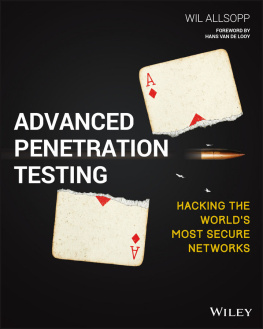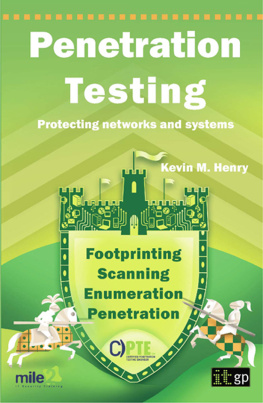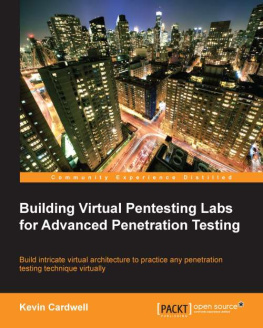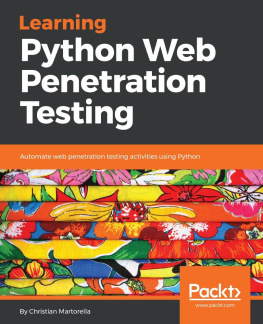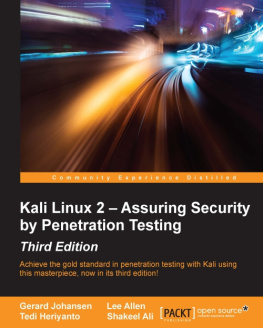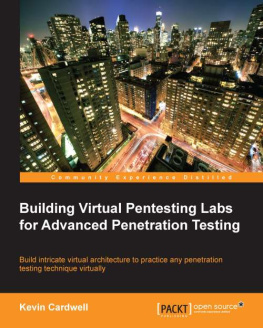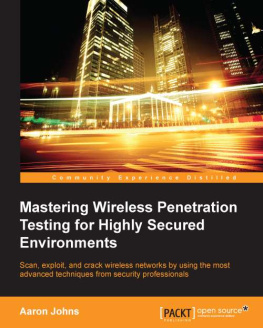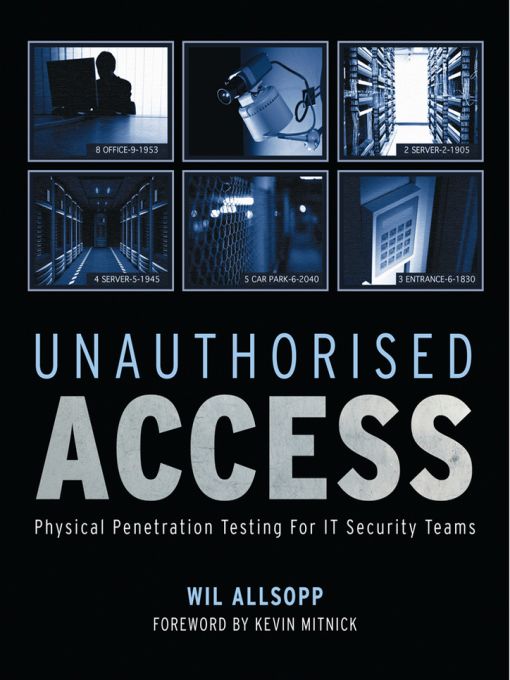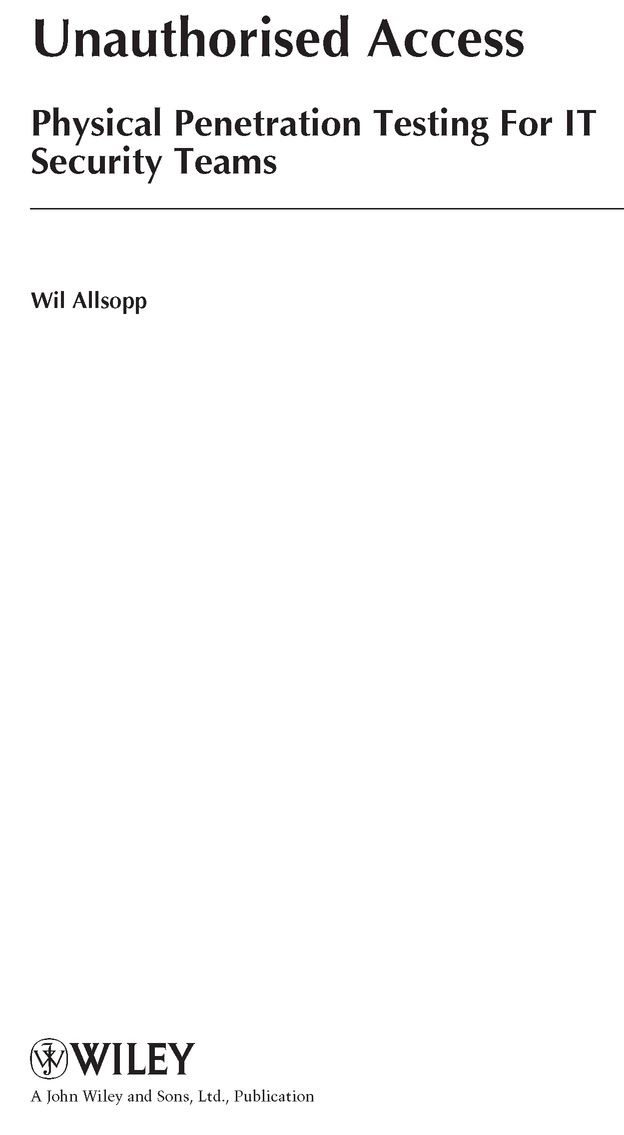Table of Contents
To Nique for being herself and to my family for supporting
and inspiring me.
Preface
This is a book about penetration testing. There is nothing innately new about that - there are dozens of books on the subject but this one is unique. It covers in as much detail as is possible the oft overlooked art of physical penetration testing rather than, say, ethical hacking. We wont teach you how to use port scanners or analyze source code. There are plenty of places you can learn about that and, to a certain degree, if youre reading this book then Im going to assume you have grounding in the subject matter anyway. The purpose of this book is twofold: to provide auditing teams with the skills and the methodology they need to conduct successful physical penetration testing and to educate those responsible for keeping attackers out of their facilities.
My personal experience in physical penetration testing began about seven years ago when, following a scoping meeting to arrange an ethical hacking engagement at a data centre in London, the client asked almost as an aside, By the way, do you guys do social engineering, that sort of thing - you know try and break in and stuff?. I responded (like any junior consultant sitting next to a senior salesman) that of course we did! As it turned out we thought about it, decided to give it a shot and ... failed. Miserably. Not surprisingly.
My team and I were hackers, lab rats. In effect, we didnt know the first thing about breaking into buildings or conning our way past security guards. This is a situation now facing an increasing number of ethical hacking teams who are being asked to perform physical testing. We know it needs to be done and the value is obvious, but where to begin? There are no books on the subject, at least none available to the general public (other than the dodgy ones on picking locks published by Loompanics
Unlimited). So I decided to fill the void and write one. It has a special emphasis on combining physical testing with information security testing simply because ethical hacking teams are most likely to be employed for this kind of work (at least in the private sector) and because ultimately its your information systems that are the most likely target for any attacker. However, anyone with a need to understand how physical security can fail will benefit from this book - the culmination of a number of years of experience performing all manner of penetration testing in all kinds of environments.
Who this Book Is For
Anyone who has an interest in penetration testing and what that entails will benefit from this book. You might have an interest in becoming a penetration tester or you might work in the industry already with an aim to learn about physical penetration testing. You might want to learn how attackers gain access to facilities and how this can be prevented or perhaps youre considering commissioning a physical penetration test and want to learn what this involves.
This book is written for you.
What this Book Covers
Unauthorized Access discusses the lifecycle of a physical penetration test from start to finish. This starts with planning and project management and progresses through the various stages of execution. Along the way, youll learn the skills that are invaluable to the tester including social engineering, wireless hacking, and lock picking.
The core subjects discuss what takes place during a physical penetration test, what you can expect and how to deal with problems. Equipment necessary to carrying out a test is given its own chapter.
Chapter 9 includes case studies that draw on my own personal testing experience, which I hope will inspire you. Chapters 10 and 11 focus on protecting against intruders and corporate spies and how this relates to the cornerstone of information security; the security policy.
The appendices deal with miscellaneous subjects such as law, accreditations and security clearance.
How this Book Is Structured
The two most important chapters in this book are Chapter 2 and Chapter 3. These contain the core theory and practice of physical penetration testing. The chapters that follow it discuss in depth the skill sets you will be required to master:
Chapter 4 - This chapter discusses how to manipulate human nature. Social engineering is the art of the con man and probably the single most crucial set of skills you will learn. The practice of these skills is at the core of any successful operating team.
Chapter 5 - Generally this concerns defeating locks. This chapter assumes no previous knowledge and these skills are not difficult to master. This is a crash course.
Chapter 6 - Knowledge is power; the more you have the more powerful you become. This chapter covers the basics of how and where to gather information, from how to successfully leverage Internet search technologies and databases through to the physical surveillance of target staff and facilities.
Chapter 7 - Despite the security shortcomings of wireless networks (both 802.11x and Bluetooth) being well documented, many companies continue to deploy them. I discuss equipment, how to crack encryption and bypass other security mechanisms. I provide you short-cuts to get you up and running quickly and introduce some newer techniques for compromising wireless networks that will guarantee that if youre using wireless in your business now, you wont be when you finish this chapter.
Chapter 8 - This chapter offers an in-depth discussion of the equipment you need, where to get it and how to use it.
Chapter 9 - This chapter offers a few historical scenarios taken from my case history. Names have been changed to protect those who should have known better.
Chapter 10 - This chapter provides basic information about what a security policy should cover. If youve read this far and still dont have a security policy, this chapter helps you write one.
Chapter 11 - This chapter covers how to minimize your exposure to information leakage, social engineering and electronic surveillance.
Appendix A - This provides a legal reference useful to UK testers.
Appendix B - This provides a legal reference useful to US testers.
Appendix C - This provides a legal reference useful when conducting testing in the European Union.
Appendix D - This clarifies the differing terms used in the United States and United Kingdom.
Appendix E - This tells you about the various tests you can take or the tests you want to be sure a tester has taken before hiring.
What You Need to Use this Book
Ive written Unauthorized Access to be as accessible as possible. Its not an overly technical read and although grounding in security principles is desirable, its not a requirement. Chapter 7 (in which the discussion focuses on compromising the security of wireless technologies) is technical from start to finish but it does not assume any previous knowledge and provides references to the requisite software and hardware as well as step by step instructions. If you have a grounding in penetration testing (or at least know what it is) so much the better but again this is not necessary.
What you need to use this book and what you need to carry out a physical penetration test are two different things (for that you should refer to Chapter 8). However, I strongly recommend you have the following:


